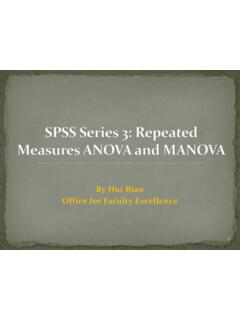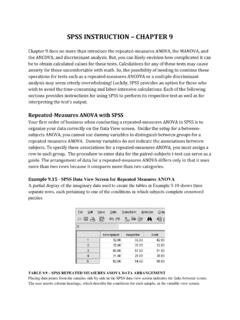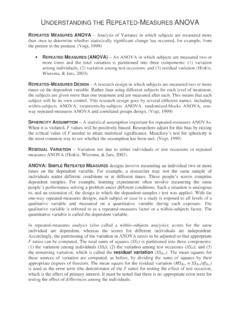Transcription of One Factor Repeated Measure ANOVA …
1 A. Chang 1 One Factor Repeated Measure ANOVA (Multivariate Approach) Example: Effect of digitalis on calcium levels in dogs Goal: To determine if the level of digitalis affects the mean level of calcium in dogs when Repeated measures were obtained from each dog. A study was conducted to compare the effect of three levels of digitalis on the level of calcium in the heart muscle of dogs. It is sufficient to note that the general level of calcium uptake varies from one animal to another so that comparisons of digitalis levels were based on Repeated measurements from the same dog. That is the tissue for a heart muscle was measured repeatedly from the same dog for the three levels of digitalis (A, B, and C).
2 Four dogs were randomly chosen in this study. 1) Enter measurements from each treatment level for all experimental subjects, each column represents a treatment, and each row represents measures from a subject. Level of Digitalis Dog A B C 1 1342 1608 1881 2 1140 1387 1698 3 1029 1296 1549 4 1150 1319 1579 Digitalis (DIJ'ih-TAL'is) is also known as digoxin (di-JOKS'in) and digitoxin (dij"ih-TOKS'in). It's a drug that strengthens the contraction of the heart muscle, slows the heart rate and helps eliminate fluid from body tissues.
3 It's often used to treat congestive heart failure and is also used to treat certain arrhythmias (ah-RITH'me-ahz). Digitalis has been described in medical literature for over 200 years. It's derived from the foxglove plant.(From The American Heart Association) A. Chang 22) Click through the following sequence of options to perform Repeated measures analysis . Analyze / General Linear Model / Repeated Measures .. 3) Enter the number of treatment levels (it would be 3 in this case for three treatment levels) and name the within subject Factor (treatment Factor variable, it is factor1 by default and it can be named differently) and click Add and click Define. A. Chang 34) Since this is a one Factor Repeated measures ANOVA , and the Factor is the Within-Subjects Factor , so the variables to be used are variables in the data sheet that represent different levels of the treatment Factor .
4 They need to be put into the Within-Subjects Factor box for the 3 Factor levels specified in the previous step for factor1 variable. A. Chang 45) Click the Model button for specifying the model for analysis . Check the Custom bullet, click on Build Terms drop down menu and select Main effects option. Then, select factor1 variable to put it in Within-Subjects Model: box and click Continue. This determines that the model to be used for the analysis will be one Factor Repeated measures model with only one treatment Factor main effect. 6) Click the Options button in the Repeated Measures dialog box, and select factor1 (the treatment variable) into Display Means for: box, and check Compare main effects box and select the multiple comparison method listed in the Confidence interval adjustment: box for multiple comparisons and click Continue and click OK in Repeated Measures dialog box.
5 A. Chang 5 SPSS Output Multivariate 's TraceWilks' LambdaHotelling's TraceRoy's Largest RootEffectFACTOR1 ValueFHypothesis dfError statistica. Design: Intercept Within Subjects Design: FACTOR1b. Mauchly's Test of SphericitybMeasure: Subjects EffectFACTOR1 Mauchly's the null hypothesis that the error covariance matrix of the orthonormalized transformed dependent variables isproportional to an identity be used to adjust the degrees of freedom for the averaged tests of significance. Corrected tests are displayed in theTests of Within-Subjects Effects Design: Intercept Within Subjects Design: FACTOR1b. Tests of Within-Subjects EffectsMeasure: AssumedGreenhouse-GeisserHuynh-FeldtLowe r-boundSphericity AssumedGreenhouse-GeisserHuynh-FeldtLowe r-boundSourceFACTOR1 Error(FACTOR1)Type III Sumof SquaresdfMean SquareFSig.
6 Tests of Between-Subjects EffectsMeasure: MEASURE_1 Transformed Variable: III Sumof SquaresdfMean SquareFSig. Pairwise ComparisonsMeasure: * * * * * * (J) FACTOR1231312(I) FACTOR1123 MeanDifference(I-J)Std. BoundUpper Bound95% Confidence Interval forDifferenceaBased on estimated marginal meansThe mean difference is significant at the .05 level.*. Adjustment for multiple comparisons: A. Chang 6To Make Profile Line Chart 1) Add a subject variable: subject, for identifying the four subjects in the study. 2) Click on Graphs option on SPSS menu bar and select Line .. option. In the Line Charts dialog box click on Multiple and also click on Summaries of separate variables bullet, and then click Define button.
7 Select all the treatment variables in Line Represent: box and put Subject variable in Category Axis: box and click OK. Level 1 Treatment Level 2 Treatment Level 3 A. Chang 7 One Factor Repeated Measure ANOVA (Univariate Mixed Effect Model Approach) (Treatment as the Fixed Effect and the Subject as the Random Effect) (This univariate approach can be used for randomized block design analysis .) 1) Setting up the data sheet 2) To run Repeated Measure analysis with univariate approach, click through the following sequence of SPSS options. Analyze/General Linear Model/ Univariate Set up of the data is similar to the Randomized Block Design situation. A. Chang 83) In the Univariate dialog box, put the response variable in the Dependent Variable box, put the Treatment variable in the Fixed Factor box, and put the Subject variable in the Random Factor box.
8 4) Click on Model button in the Univariate dialog box, and first click on the drop-sown menu below Build Term(s) title and select Main effects option, and then use the selection button to select and select trtmt (Treatment) and subject variables as Main effects, and click Continue. A. Chang 95) For performing Post Hoc analysis : First, click Post Hoc button in the Univariate dialog box and the following dialog will appear. Select the trtmt variable in Post Hoc Tests for: box and check S-N-K box and then click Continue button. 6) For making a profile chart, in Univariate dialog box, click on Plot button. Put subject variable in Horizontal Axis and put trtmt variable in Separate Lines. SPSS will draw profile line chart.
9 Each line in the chart will represent outcome from each of the treatment group. Click Add to add the chart to the list to be plotted, and click on Continue button. 7) After all the options have been selected, click OK in the Univariate dialog box to execute the analysis . A. Chang 10 Output for Using Univariate Approach with Treatment as the Fixed Effect and the Subject as the Random Effect Tests of Between-Subjects EffectsDependent Variable: III Sumof SquaresdfMean SquareFSig. MS(SUBJECT)a. MS(Error)b. ResponseStudent-Newman-Keulsa, for groups in homogeneous subsets are on Type III Sum of SquaresThe error term is Mean Square(Error) = Harmonic Mean Sample Size = Alpha = . Estimated Marginal Means of Marginal Means200018001600140012001000800 Treatment
















